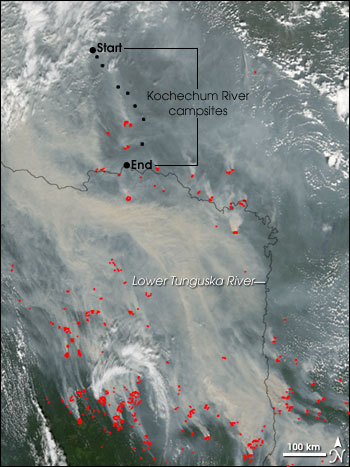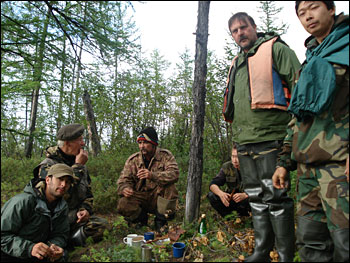| |
 |
| |
Wednesday, August 8, 2007
From Evenkiyskiy Region, 10:38 p.m. Siberia (10:38 a.m. EDT)
The Kochechum is a curious river. The chilly headwaters begin in snowmelt and rain in the basaltic mountains north of the Arctic Circle. These waters flow southerly to the town of Tura and join the Lower Tunguska River. That river heads northwest until the waters spill into the Yenisey River near the town Turukhansk. The Yenisey turns northerly, ending at the Kara Sea which opens to the Arctic Ocean. After looping away from the Arctic Circle and back, the waters of the Kochechum end up farther north than they begin.
The expedition began travel near the starkly remote headwaters of the Kochechum. The water that carries them will soon join those that flowed past Krasnoyarsk, the third largest city in Russia. The Yenisey drains over 2.5 million square kilometers of land; although the team rides the remote waters alone, the river connects them to the wider world.
From Jon Ranson
Today was a day for both samples and travel. Slava and Pasha got up very early to take samples for the fire studies. By the time they got back, we’d loaded all the gear into the boats and were ready to go. We spent about three hours moving, then stopped for more samples, and eventually made camp on another stony island.
|
|
- Introduction
- July 28, 2007
- July 29, 2007
- July 30, 2007
- July 31, 2007
- August 1, 2007
- August 2, 2007
- August 3, 2007
- August 4, 2007
- August 5, 2007
- August 6, 2007
- August 7, 2007
- August 8, 2007
- August 9, 2007
- August 10, 2007
- August 11, 2007
- August 12, 2007
- Biographies
|
| |

Slava tells me that his fire samples are already quite interesting. He is searching for trees that have lived through several burns, so he can judge how often fires return to the area. Because mature larch trees are fire-resistant, he expected to find many such trees. However, the fires here have been “catastrophic”—so hot that they tend to kill all the trees, old and young alike. The trees that have survived more than a single fire here are found on the farthest margins of burns or in locally wet areas. It is unusual that the fires are this intense.
|
|
The team has found fewer larch trees than they expected bearing signs of having survived previous fires. Slava thinks this is evidence that fires have been catastrophic. This image from the MODIS sensor on NASA’s Aqua satellite shows fires (red dots) across Siberia on July 24, 2006, one year before the team’s trip down the Kochechum River (riverside campsites marked with black dots). The expedition will end at Tura, where the Kochechum flows into the Lower Tunguska River. The Lower Tunguska flows northwest into the Yenisey River and on to the Arctic Ocean.
|
| |

While on the river we went through a narrow canyon. The steep sides were made of several layers of basalt, each representing a different, ancient flow of lava. Because basalt is basically dark gray, the layers were quite dark, but there were bits of brighter colors here and there—small bits of other rocks formed by volcanic heat and pressure. The shore of the river is like this, too. The rocks are almost all gray, but scattered here and there are the most amazing bits of bright red, yellow, green, and blue rocks. There’s white quartz, too. The little sparks among the dark can be dazzling.
We met our first people today! We stopped by a new structure on the riverbank, and soon a man and a teenaged boy motored in on their boat. It turns out they are working on a camp for high school students from Tura. They gave us dried fish, and we shared what we had with them. It was nice to hear other people talking and to get the latest news of the river conditions.
|
|
Slava and Pasha cut a larch tree for the fire return interval study. They will cut a thin cross-section from the tree then take it back to their laboratory for further analysis. The growth rings will be counted and measured using a microscope to determine the time interval between fires. This study will help them understand whether fires have been increasing over the years and if so, whether more fires could be associated with temperature increases in the region.
|
| |

Speaking of boats and motors, our experiment with re-wiring the 12-volt plug on our motors has not worked. I don’t know why—everything looks exactly right. I have learned that next time I’ll bring extra batteries for the computer. I’ll bring a volt-meter, too, in case I want to do some more experiments on the wiring. We are here to learn, aren’t we?
 August 9, 2007 August 9, 2007
 August 7, 2007 August 7, 2007
|
|
The team takes time out from the river to share refreshments with Valeri and his assistant, who are preparing a nature camp for a Tura high school on Kochechum River. These are the first people the team has seen since the expedition started 11 days ago.
|

